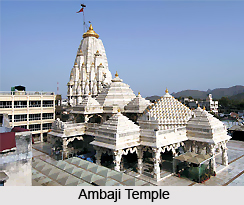 Patan district is located in northern Gujarat, surrounded by Banas Kantha District to its north and northeast, Mehsana to its south and Kutch District and Kutch nu Nanu Ran (Little Rann of Kutch) to the southeast. The eastern areas, Harij and Sami, bordering Kutch are quite susceptible as there is no settled population between these two areas and the border of Pakistan even though geographically it is quite a few miles away. The district was carved out mainly from Mehsana district along with Radhapur and Santalpur Talukas from Banaskantha district. The headquarters are located in the city of Patan, with a population of 1,182,709 (2001 census). The city of Patan was the capital of Gujarat in medieval times. Patan has a number of temples for the Hindus and Jains, as well as mosques, dargahs and rojas. Though the population of Hindus and Muslims are almost equal in the city, yet Jain temples are more noticeable. There are 122 Jain temples, all of which are 100 years old, and 9 Hindu temples.
Patan district is located in northern Gujarat, surrounded by Banas Kantha District to its north and northeast, Mehsana to its south and Kutch District and Kutch nu Nanu Ran (Little Rann of Kutch) to the southeast. The eastern areas, Harij and Sami, bordering Kutch are quite susceptible as there is no settled population between these two areas and the border of Pakistan even though geographically it is quite a few miles away. The district was carved out mainly from Mehsana district along with Radhapur and Santalpur Talukas from Banaskantha district. The headquarters are located in the city of Patan, with a population of 1,182,709 (2001 census). The city of Patan was the capital of Gujarat in medieval times. Patan has a number of temples for the Hindus and Jains, as well as mosques, dargahs and rojas. Though the population of Hindus and Muslims are almost equal in the city, yet Jain temples are more noticeable. There are 122 Jain temples, all of which are 100 years old, and 9 Hindu temples.
Ambaji Temple, Patan, Gujarat: Dedicated to goddess Parvati, Ambaji Temple is laced with curious stories believed by the devotees since time immemorial.
Bahucharaji Temple, Mehsana, Patan, Gujarat: Bahucharaji Temple has the involvement of royal affairs, evident in its crafty workmanship.
Taranga Jain Temple, Mehsana, Patan, Gujarat: A noted pilgrim centre of the Jains, Taranga Temple has been built flamboyantly, evident in its carvings and sculptural works.





















